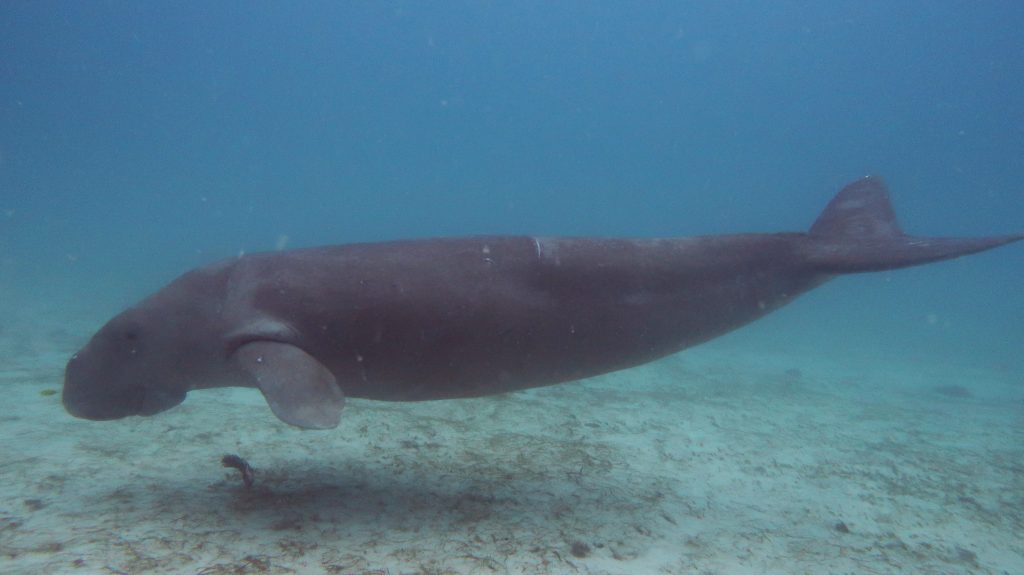Dugongs of El Nido and Coron: Treasures of the Palawan Waters
Discover El Nido and Coron’s enchanting dugongs – guardians of seagrass meadows. Explore their vital role and conservation efforts.
Dugong encounters while diving are extremely rare here in El Nido. More frequently, we manage to catch a glimpse from the boat on the surface. However, during our dives, we can tally the encounters on just one hand when combining reports from various diving centers. Our encounters have mainly occurred at the Helicopter and Nat Nat diving sites, both known for their abundant sandy areas with seagrass.
Here is a link to one of these exceptional encounters with these animals often referred to as the “mermaids of the sea. Join us as we dive into the captivating world of dugongs around El Nido and Coron, exploring their significance, the magic they bring to these destinations, and the efforts to ensure their conservation.

The Enigmatic Dugongs: Guardians of the Seagrass Meadows
Dugongs are gentle marine mammals that have captured the imagination of cultures around the world for centuries. These herbivorous creatures, closely related to manatees, are known for their serenely slow movements and unique appearance. However, beyond their graceful exterior lies an important ecological role: dugongs are guardians of the seagrass meadows. These underwater gardens provide crucial habitats for countless marine species, stabilize the ocean floor, and contribute to carbon storage—a testament to the intricate balance of nature.
Seagrass Meadows: The Lifeline of Dugongs
Seagrass meadows are unique and vital marine ecosystems that serve as a sanctuary for a plethora of marine species, including the beloved dugongs. These underwater gardens are characterized by vast stretches of lush seagrass beds swaying gently in the currents. Palawan’s coastal waters provide the perfect environment for these meadows to flourish, making them a haven for marine life.
The Perfect Palawan Habitat
Dugongs are herbivorous marine mammals, and their diet mainly consists of seagrasses. Palawan’s seagrass meadows offer a buffet of nutrient-rich seagrasses that are a staple of the dugong’s diet. The calm and clear waters, as well as the rich sedimentation in these areas, create an ideal environment for seagrass growth. This abundance of seagrass sustains a healthy dugong population, making Palawan a critical habitat for their survival.
A Balanced Ecosystem
The interdependence of dugongs and seagrass meadows highlights the delicate balance of marine ecosystems. As dugongs graze on seagrasses, they help control their growth, preventing overgrowth that could choke the meadows. In return, healthy seagrass beds provide dugongs with nourishment and shelter. Additionally, seagrass meadows serve as breeding and nursery grounds for various fish species, contributing to the overall biodiversity of the region.


Habitat
Dugongs can be found in several areas around Palawan, Philippines, where they inhabit the seagrass meadows that provide their primary food source. While there is no precise or up-to-date data on the exact numbers of dugongs in each location, here are some of the areas in Palawan where dugongs are known to be present:
- El Nido: El Nido, located in the northern part of Palawan, is renowned for its stunning landscapes and clear waters. The seagrass meadows around El Nido offer an ideal habitat for dugongs. In this area visitors have reported sightings of dugongs while snorkeling or diving in the vicinity.
- Coron: Coron, also situated in the northern region of Palawan.
- Taytay Bay: Taytay Bay, located between El Nido and Puerto Princesa, is another known habitat for dugongs.
- Port Barton: Port Barton, a quieter and more secluded destination in Palawan, also boasts seagrass meadows that attract dugongs.
- Honda Bay: Situated near Puerto Princesa, Honda Bay is known for its island-hopping tours and vibrant marine life. Dugongs have been occasionally sighted in this area.
It’s important to note that dugongs are known to be elusive and can be challenging to spot. Their populations are also considered vulnerable due to factors such as habitat loss, accidental entanglement in fishing gear, and boat strikes. Conservation efforts are being implemented to protect both dugongs and their habitats in Palawan, emphasizing responsible tourism, sustainable fishing practices, and awareness campaigns.
While dugong populations are difficult to quantify accurately, the presence of these gentle marine mammals in Palawan’s waters underscores the significance of the seagrass meadows and the need to preserve these habitats to ensure the survival of dugongs and the marine ecosystems they support.
